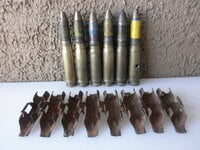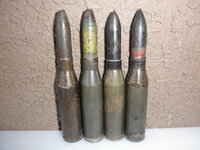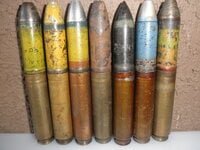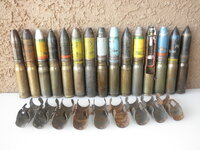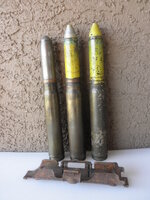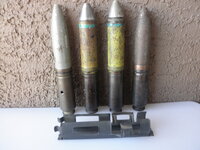The only thing I can think of is that Lancs (and Halifaxes) had more weight in their defensive armament with the total weight of guns ammunition turrets and maybe strengthening needed for them at the rear.Here's some background - the text which accompanied that photo on FB's 'PlaneHistoria' (I fianlly found it!)
'The incredible power of the German MK 108 30 mm autocannon is shown here on this Blenheim IV light bomber, which was hit by the weapon during British tests. Even the stoutly-constructed and rugged B-17 Flying Fortress was known to disintegrate when hit with as little as four MG 108 rounds, and the more lightly constructed RAF Lancaster and Halifax heavy bombers were even more susceptible to fatal battle damage from this weapon.'
To which I replied:
'can I see some evidence to back up the claim that the Lancaster was more lightly constructed than a B17? I find this slightly difficult to accept without clarification'
Reply
Rod Wylie
plenty of evidence around.
The Lanc was built light so as to carry large bomb loads.
Good read would be Lancaster Men by Peter Rees.
Me
Rod Wylie and yet it has an unladen weight almost the same as a B17 and is slightly smaller in all dimensions...? I'm crying BS
Jon Chapman
it was built differently, using a geodesic tubular steel design which had a very high strength/weight ratio, and was more spacious and could vary a higher volume as well as weight.
Rod Wylie
Or maybe'Big week' by James Holland
Me
Rod Wylie instead of digging yourself in even deeper, find me an extract from either book which refers to the Lancaster being 'lightly built' or more vulnerable to battle damage than contemporary four engined bombers.
Rod Wylie
Jeez , I'm a busy man.
Cant you read them yourself ?
Me
No, because there don't seem to be any [references online]. Someone with your self declared level of expertise and certainty should easily be able to dig those references out, eh?
... y'all know - the usual social media descent into snippy comments and replies (mea culpa!). But in all seriousness, has anyone ever heard anything to support this claim? As others have noted, Lancaster vulnerability would seem to be because of the nature of night fighting and context, NOT the airframe per se. As for 'lightly built', surely that is indeed just boll0c£s?
Navigation
Install the app
How to install the app on iOS
Follow along with the video below to see how to install our site as a web app on your home screen.
Note: This feature may not be available in some browsers.
More options
You are using an out of date browser. It may not display this or other websites correctly.
You should upgrade or use an alternative browser.
You should upgrade or use an alternative browser.
Sciatica, Facebook, Aviation themed pages and a claim about B17 and Avro Lancaster...
- Thread starter SplitRz
- Start date
Ad: This forum contains affiliate links to products on Amazon and eBay. More information in Terms and rules
More options
Who Replied?ThomasP
Chief Master Sergeant
PS - in addition to the above... I'm sure I remember reading somewhere that part of the Lancaster's strength derived from the original spec which included the capability of being catapult launched (I think this relates to short airfields rather than for naval employment and at a period when the RAF hierarchy were increasingly unsure how these ever heavier aircraft would get into the air unless runways were massively increased in length )
Is that false memory on my behalf, or maybe a since disproven myth?
I have read that all of the first 4 heavies (ie Stirling, Manchester, Lancaster, and Halifax) weighed a bit more because the early/original Specification required them to be compatible with assisted TO methods. I do not know how accurate this is, or how much weight could be accounted for by the requirement, as the requirement was relaxed or removed for all except the Stirling?
I have also read that there were tests of assisted TO for the Stirling, where a trough in the ground was used as a track for some sort of heavy mover vehicle that pulled the Stirling, helping it accelerate during the early stage of TO. I believe the results showed the concept worked, but it turned out not to be needed in service.
I think the article describing the tests was in one of the RAFHS periodicals.
Last edited:
Shortround6
Lieutenant General
Well.I have read that all of the first 4 heavies (ie Stirling, Manchester, Lancaster, and Halifax) weighed a bit more because the early/original Specification required them to be compatible with assisted TO methods. I do not know hw accurate this is, or how much weight could be accounted for by the requirement, as the requirement was relaxed or removed for all except the Stirling?
I have also read that there were tests of assisted TO for the Stirling, where a trough in the ground was used as a track for some sort of heavy mover vehicle that pulled the Stirling, helping it accelerate during the early stage of TO. I believe the results showed the concept worked, but it turned out not to be needed in service.
I think the article describing the tests was in one of the RAFHS periodicals.
This is supposed to be the prototype Manchester although no date is given. The Stirling first flew before the Manchester (by a couple of months) so it is quite possible that the Stirling had the catapult requirement at some point in it's life.
One does wonder if the wheel tracks were ever standardized or if the catapults were 'adjustable'.
There is also this link
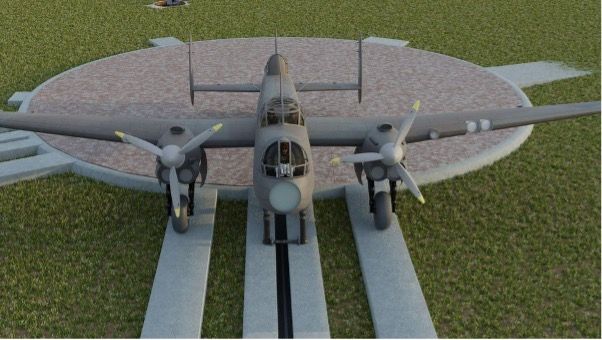
Archaeologists Unearth World War II-Era Air Catapult System In UK - AVweb
Early example of aircraft catapult launcher preserved in England
 www.avweb.com
www.avweb.com
On Youtube there is a clip of a Vickers Virginia bomber being catapulted in 1931.
GrauGeist
Generalfeldmarschall zur Luftschiff Abteilung
The Stirling, Halifax and Lancaster were well built machines, there is no doubt about it.
However, it's been said that Boeing "over-built" the B-17. I doubt this was actually the case. The B-17 was designed to be rugged and that concept proved valuable years later, when it was put to the test during the war.
It was able to absorb damage that most other heavy bombers simply could not withstand, and still remain in the air.
This virtue *may* lead some to assume other Allied bombers were fragile, but this is simply not the case.
However, it's been said that Boeing "over-built" the B-17. I doubt this was actually the case. The B-17 was designed to be rugged and that concept proved valuable years later, when it was put to the test during the war.
It was able to absorb damage that most other heavy bombers simply could not withstand, and still remain in the air.
This virtue *may* lead some to assume other Allied bombers were fragile, but this is simply not the case.
ThomasP
Chief Master Sergeant
If you go through the weight and loading charts and subtract all the gun armament (ie turrets and ammo) and armour, the difference in weight due to crew size, and the other removable equipment and useful load items, the B-17F/G, B-24D+, Halifax Mk IIA, and Lancaster Mk I/III, all have about the same TARE weight. As far as I can tell the weights come out to 32,000 - 34,000 lbs, depending on what you count as removable - everything being equal the weights come out within ~1000 lbs.
Last edited:
Jimbob
Airman 1st Class
I think the good chap is really confused, he seems to be talking of the Wellington with mention of the geodesic airframe, again incorrect with the tubular steel mention, they were pressed duralumin.it was built differently, using a geodesic tubular steel design
Shortround6
Lieutenant General
That is because all the elves and their little files were making Merlin enginesLancasters were made from a solid billet of cast iron with a few holes milled out here and there for the bombs and crew, this was done after lunch by housewives in Manchester and Liverpool.
It is quite possible that the B-17s were over built. The Model 299 flew for the first time about 3 months after the Bristol Type 142.
Not a lot of people knew much about large 4 engine aircraft in 1934-38.
The older designed XB-15 wasn't completed until Oct 1937, 2 1/4 years after the Model 299.
Of the 13 YB-17s the last one was supposed to be ground tested to destruction for engineering data. When one of the earlier ones got caught in a thunderhead, flipped upside down and exited the cloud in an inverted spin and recovered with bent wings and popped rivets that was judged to enough structural testing
They did have to beef up certain parts to almost double the MAX gross weight of the plane. However most (all?) of these 4 engine bombers when operated at anywhere near max gross weights in the later part of the war were operating under restrictions that the older/early planes did not have. Both in flying characteristics and ground handling (like no pivot turns and extra care taken in getting to the runway from disperse (ground guides checking condition of the ground etc)
Trying to compare the B-17s to the British planes is a bit hard as they often did not fly the same profile missions. There seems to be little doubt that the B-24 was not quite as strong as the B-17 or at least the wing spars seemed to fail with somewhat less flame impingement. However that may have been just enough time for a few more men to bail out, not that the plane was going to make it home.
wuzak
Captain
PS - in addition to the above... I'm sure I remember reading somewhere that part of the Lancaster's strength derived from the original spec which included the capability of being catapult launched (I think this relates to short airfields rather than for naval employment and at a period when the RAF hierarchy were increasingly unsure how these ever heavier aircraft would get into the air unless runways were massively increased in length )
Is that false memory on my behalf, or maybe a since disproven myth?
Yes, the specification for the Manchester required it to be able to be catapult launched when overloaded.
wuzak
Captain
I have read that all of the first 4 heavies (ie Stirling, Manchester, Lancaster, and Halifax) weighed a bit more because the early/original Specification required them to be compatible with assisted TO methods. I do not know how accurate this is, or how much weight could be accounted for by the requirement, as the requirement was relaxed or removed for all except the Stirling?
I have also read that there were tests of assisted TO for the Stirling, where a trough in the ground was used as a track for some sort of heavy mover vehicle that pulled the Stirling, helping it accelerate during the early stage of TO. I believe the results showed the concept worked, but it turned out not to be needed in service.
I think the article describing the tests was in one of the RAFHS periodicals.
The Manchester and the HP.56 were designed around the catapult requirement.
The twin engine HP.56 didn't continue and was replaced by the four engine HP.57 Halifax. Not sure if the Halifax carried over much from the unbuilt HP.56 design.
The Lancaster inherited most of the Manchester's structure, so the strength for the catapult launch remained.
wuzak
Captain
Here's some background - the text which accompanied that photo on FB's 'PlaneHistoria' (I fianlly found it!)
'The incredible power of the German MK 108 30 mm autocannon is shown here on this Blenheim IV light bomber, which was hit by the weapon during British tests. Even the stoutly-constructed and rugged B-17 Flying Fortress was known to disintegrate when hit with as little as four MG 108 rounds, and the more lightly constructed RAF Lancaster and Halifax heavy bombers were even more susceptible to fatal battle damage from this weapon.'
To which I replied:
'can I see some evidence to back up the claim that the Lancaster was more lightly constructed than a B17? I find this slightly difficult to accept without clarification'
Reply
Rod Wylie
plenty of evidence around.
The Lanc was built light so as to carry large bomb loads.
Good read would be Lancaster Men by Peter Rees.
Me
Rod Wylie and yet it has an unladen weight almost the same as a B17 and is slightly smaller in all dimensions...? I'm crying BS
Jon Chapman
it was built differently, using a geodesic tubular steel design which had a very high strength/weight ratio, and was more spacious and could vary a higher volume as well as weight.
Rod Wylie
Or maybe'Big week' by James Holland
Me
Rod Wylie instead of digging yourself in even deeper, find me an extract from either book which refers to the Lancaster being 'lightly built' or more vulnerable to battle damage than contemporary four engined bombers.
Rod Wylie
Jeez , I'm a busy man.
Cant you read them yourself ?
Me
No, because there don't seem to be any [references online]. Someone with your self declared level of expertise and certainty should easily be able to dig those references out, eh?
... y'all know - the usual social media descent into snippy comments and replies (mea culpa!). But in all seriousness, has anyone ever heard anything to support this claim? As others have noted, Lancaster vulnerability would seem to be because of the nature of night fighting and context, NOT the airframe per se. As for 'lightly built', surely that is indeed just boll0c£s?
Jon Chapman may have been confusing the Lancaster with the Wellington!
I would say the Manchester had to be "over engineered" compared to many other designs of the day simply because it had three very heavy turrets and the rear gunner had to be able to access his turret. There was little change from the Manchester to Lancaster fuselage design, the Lancaster ended up carrying bomb loads that a Manchester couldnt dream of getting off the ground even if its two Vulture engines performed as expected.
- Thread starter
- #34
..all of which, in addition to being stressed for catapult launching (an airframe testing experience without doubt and NOT something a 'lightly built' airframe would likely cope with on a repeated basis) AND having an unladen weight around the same as the B17 leads me to conclude...I would say the Manchester had to be "over engineered" compared to many other designs of the day simply because it had three very heavy turrets and the rear gunner had to be able to access his turret. There was little change from the Manchester to Lancaster fuselage design, the Lancaster ended up carrying bomb loads that a Manchester couldnt dream of getting off the ground even if its two Vulture engines performed as expected.
...that Facebook 'experten' Rod Wylie is.. <ahem, polite cough>, grossly mistaken and might be construed by a gentleman as someone who is talking out his hat
Thank you folks - forgot my sciatica for while!
My take on it, reading German night fighter reports the preferred way to attack the heavies was to sneak up from underneath and aim at the wing either between the inner engine and wing root or between the engines themselves, remember too that we are talking very close range, within a 100 meters and with two 20mm cannons spaced only .5 to 1 meter apart, taking that into consideration I doubt very much any four engined bomber, Lanc Halifax B17 B24 B29 would survive a two second burst of mine shells concentrated into such a small area from such close range, it would also explain why very few crew members got out as once the wing integrity was lost and the wing folded the plane would rapidly go out of control.However, it's been said that Boeing "over-built" the B-17. I doubt this was actually the case. The B-17 was designed to be rugged and that concept proved valuable years later, when it was put to the test during the war.
It was able to absorb damage that most other heavy bombers simply could not withstand, and still remain in the air.
Antarctica
Airman
- 88
- May 20, 2023
British aircraft like the Blenheim were quite lightly built. That photo looks like the shell was filled with explosive not a solid shot like ordinary bullets.
British aircraft like the Blenheim were quite lightly built.
Those that were like other aircraft were not lightly built. Granted, there was a number of British aircraft that were lighter built than the Blenheim
That photo looks like the shell was filled with explosive not a solid shot like ordinary bullets.
Those unsporty Germans - filling their shells with explosives
GrauGeist
Generalfeldmarschall zur Luftschiff Abteilung
The German's 20mm and 30mm HE cannon rounds were called "Minengeschoß", which literally means "mine shell".
Shortround6
Lieutenant General
Quite true, however for contextBritish aircraft like the Blenheim were quite lightly built. That photo looks like the shell was filled with explosive not a solid shot like ordinary bullets.
The Blenheim was not a large aircraft and only limited expansion space.
Location of hits was very important for the success of the Mine shells. The 20mm versions were not very successful when hitting cavernous fuselages. They could often make hundreds of tiny holes but unless they were close to something like a hydraulic line or control cable they sometimes could not break them.
The British shot up a fair number of Blenheims on test ranges. They had a lot of them, They had a bunch damaged on operations or training. It gave sort of standard target.
Shooting up 4 different aircraft, one Hurricane (fabric rear fuselage), one Spitfire (small fuselage), One Blenheim and one Short Stirling with different guns/ammo is going to give rather different results. You are going to get different results using different aircraft using the same gun/ammo which is somewhat useful but if you don't have a "standard" to begin with it is somewhat less useful.
I wish you a speedy recovery. As an aside, I agree with the drugs based approach to managing pain. I think that it's one too far with doctor saying that we need to cope with pain naturally. Once you get pain you realize it has to be coped with, so good luck.Thank you - this is the pic! And thanks for your wishes - much appreciated. Tramadol, Gabapentin and Codeine are due to visit me once again in about two hours. This can be the tricky bit...
EDIT - that picture really shows how lightly constructed the Blenheim was!
I remember my dad telling me what went into a 20 mm Canon shell for the aircraft of that time ( he was an aircraft technician in the RAF).
He said they were about £20 per shell mid seventies prices.
When I look at the construction of the various mine shells provided in the links with specialized detonators, I can see where that cost came from.
So the decision by the USAAF to use the 0.5 in Browning throughout its fleet was also a good economic one.
Users who are viewing this thread
Total: 1 (members: 0, guests: 1)

